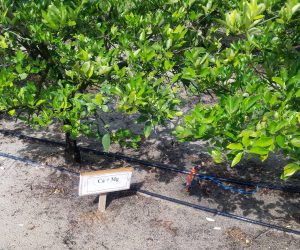UF/IFAS researchers are trying to extend the life of citrus trees infected with Huanglongbing (HLB), a bacterial disease. New research shows magnesium may play an important role in boosting the productivity of HLB orange trees. Specifically, the researchers looked at the concentrations of the three nutrients in tree leaves and the soil.

Over 18 months, they collected samples from a grove of Valencia orange trees at the UF/IFAS Citrus Research and Education Center. The test plots in the study had varying amounts of nitrogen. Furthermore, they subdivided those and applied different amounts of calcium, magnesium, and a combination of calcium and magnesium.
Results
Dr. Gabriel Maltais-Landry is an assistant professor of sustainable nutrient management systems in the UF/IFAS soil and water sciences department (SWS). He said the different nitrogen rates did not affect leaf nitrogen and soil extractable concentrations. Similarly, the application of calcium did not increase soil calcium extractable concentration relative to the grower standard. It did have a slight effect on leaf calcium, however.
“In contrast, magnesium was effective at increasing both leaf and soil magnesium concentrations,” he said. “Overall, our results suggest a greater impact of magnesium fertilization on soil and nutrient concentrations than nitrogen or calcium fertilization.”
Dr. Davie Kadyampakeni is an assistant professor of citrus water and nutrient management at the UF/IFAS Citrus Research and Education Center and co-author of the research article. He said future studies with a larger sample size and longer duration could help determine the strength of these interactions and their long-term implications. Additionally, measuring nutrient losses through leaching in the future would provide a more thorough understanding of the fate of these nutrient inputs.
“Overall, this study provides insights on the benefits of a balanced nutrition approach to ensure the optimal growth of HLB-affected citrus trees in Florida,” he added.
The publication in the journal Nutrient Cycling in Agroecosystems is based on former SWS graduate student Eduardo Esteves’ master’s degree research. You can see the full article here: https://link.springer.com/article/10.1007/s10705-021-10182-1. Funding for the research came from the USDA Multi-Agency Coordination (MAC) Group, which includes the department’s Animal and Plant Health Inspection Service (APHIS), and the UF/IFAS Citrus Initiative.
A companion publication on the nutrients’ role in boosting the productivity of affected trees appears in the journal HortScience: https://doi.org/10.21273/HORTSCI15997-21.
 0
0
